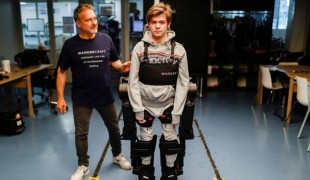- 4978
- 406
- 11
- 14
- 0
- Help Ukraine
About the solution
Amit had also created ReWalk, a robotic exoskeleton to help patients with lower limb disabilities to walk. But being a tetraplegic himself, he wasn’t able to use the ReWalk. But now he can benefit from UPnRIDE.
Being quadriplegic after a car crash in 1997, he always wondered why the wheelchair was the only solution that allowed paraplegic people to move around. “I could not realize how come towards the end of the 20th century disabled people have no other solution other than a wheel chair”, he stated.
This new patented product is very similar to the Segway, but has four wheels, and allows quadriplegics to be fully mobile in both standing and sitting positions, indoors or outdoors.
“Rewalk is the best solution for paralyzed people but it is good for 10 percent of the wheelchair population, those who have use of their upper body because you need to be able to hold the crutches,” said Oren Tamari, the CEO of the Yokneam, Israel-based startup. “However, 90 percent of the wheelchair population still has no satisfactory solution for functional upright mobility. UpNRide’s solution is for those people, like Amit himself, who can’t use ReWalk.”
What was more important to Amit was to be able to stand up, allowing him to interact socially, eye-to-eye. “Being able to stand and move is extremely important for people’s psychological health”.
The price of the UPnRIDE is stil undefined, but it will be between 15.000 USD and 45.000 USD.
Adapted from: http://bit.ly/2gihmpu
More info: http://upnride.com
What about you? Please post your solutions here, on the Patient Innovation platform!
https://youtu.be/3AAjy8-zCT8
This solution shall not include mention to the use of drugs, chemicals or biologicals (including food); invasive devices; offensive, commercial or inherently dangerous content. This solution was not medically validated. Proceed with caution! If you have any doubts, please consult with a health professional.
DISCLAIMER: This story was written by someone who is not the author of the solution, therefore please be advised that, although it was written with the utmost respect for the innovation and the innovator, there can be some incorrect statements. If you find any errors please contact the patient Innovation team via info@patient-innovation.com
-
-
246
-
0
-
2711

Collaborator James Leckey makes equipment to improve the quality of life and social inclusion of children with special needs
MOVING IN A WHEELCHAIR: Moving using a wheelchair.
BODY BALANCE: Maintaining body balance
STANDING UP: Standing up from a seated position
Playing
Neuromuscular Disorders
Assistive Daily Life Device (to help ADL)
Walking Aid (wheelchair/walker/crutches)
Assistive Technology access
5 Senses support devices: (glasses, hearing aids, headphones...)
Restoring mobility
Promoting self-management
Managing Neurological Disorders
Promoting inclusivity and social integration
Maintaining Balance and Mobility
Raise awareness
General and Family Medicine
Neurology
Orthopedics
Pediatrics
Physical Medicine and Rehabilitation
United States
-
-
-
714
-
0
-
9334

Former wheelchair user creates open source wheelchair
WALKING WITH A WALKING AID: Walking with a walking aid
Post-Polio Syndrome
Muscular Dystrophy
Neuromuscular Disorders
Cerebral Palsy
Cervical spinal cord injury/Tetraplegia
Walking Aid (wheelchair/walker/crutches)
Assistive Daily Life Device (to help ADL)
Muscle cramps or spasms
Difficulty coordinating movements
Stiffness or rigidity (difficulty moving)
Paralysis of the legs and lower body
Muscle weakness
Restoring mobility
Promoting self-management
Managing Neurological Disorders
Maintaining Balance and Mobility
Preventing (Vaccination, Protection, Falls, Research/Mapping)
General and Family Medicine
Infectious Diseases
Medical Genetics
Neurology
Orthopedics
Public Health
Kenya
-
-
-
401
-
0
-
5597

Father creates exoskeleton to help son with genetic neurological condition walk
BODY BALANCE: Maintaining body balance
STANDING UP: Standing up from a seated position
WALKING WITH A WALKING AID: Walking with a walking aid
CAREGIVING
Cervical spinal cord injury/Tetraplegia
Assistive Technology access
Walking Aid (wheelchair/walker/crutches)
Restoring mobility
Managing pain
Promoting self-management
Preserving Organ Function
Managing Neurological Disorders
Recovering from Traumatic Injuries
Maintaining Balance and Mobility
Restoring Blood Circulation
To improve Treatment/Therapy
Preventing (Vaccination, Protection, Falls, Research/Mapping)
Raise awareness
Caregiving Support
General and Family Medicine
Intensive Care Medicine
Neurology
Physical Medicine and Rehabilitation
Sports Medicine
France
-
 en
en